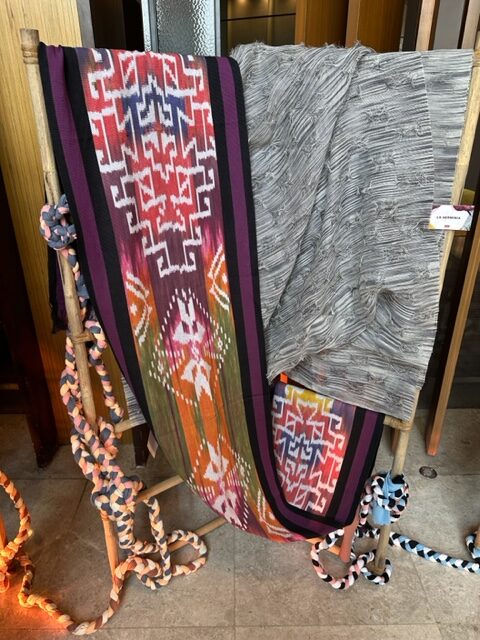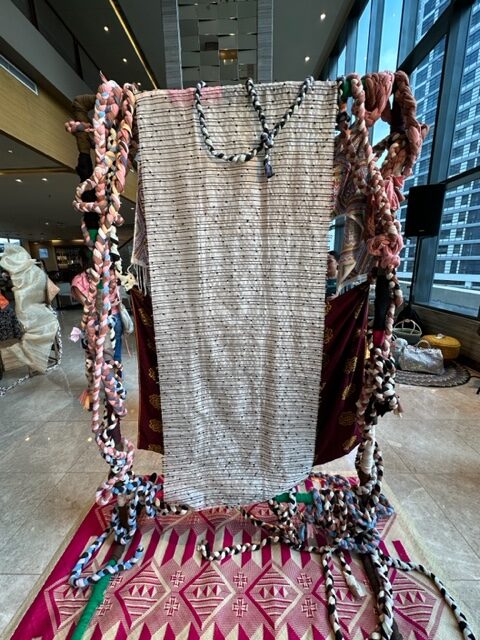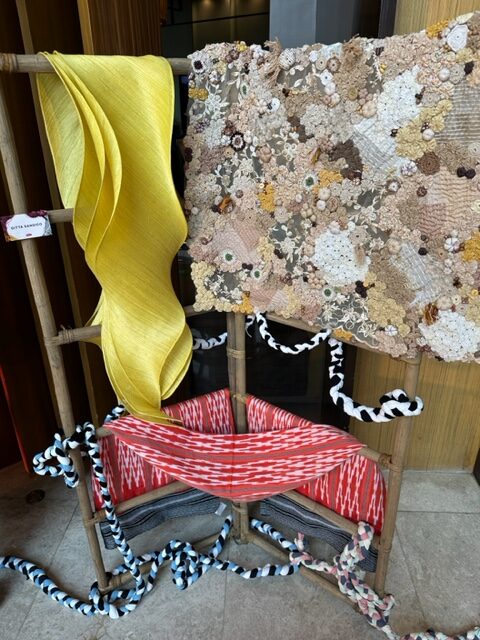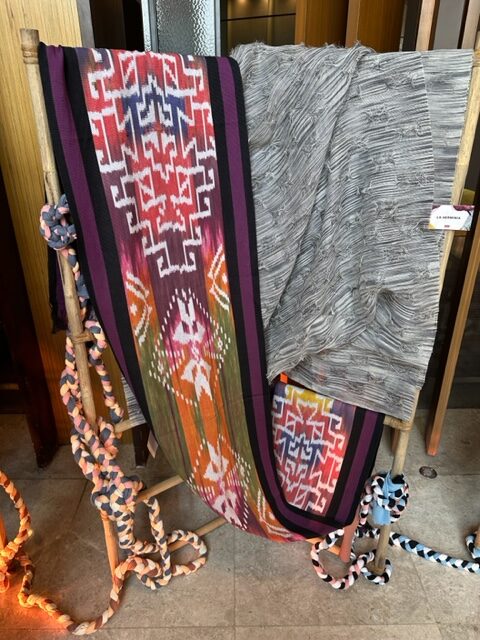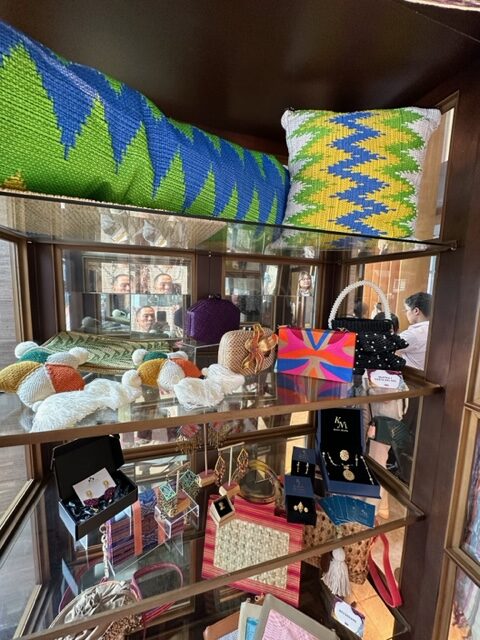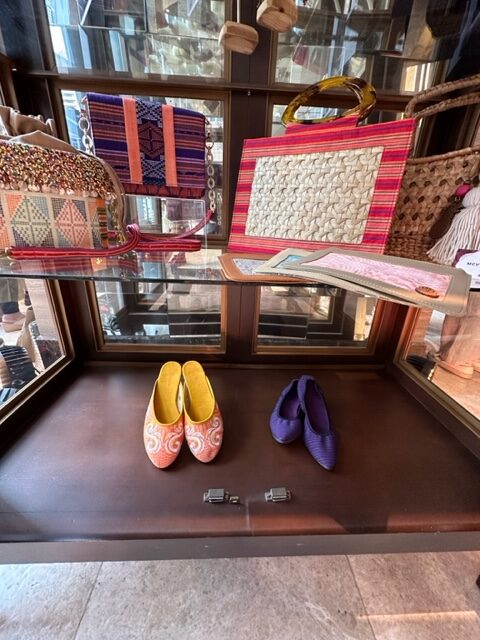Slated from Oct. 13 to 15 at the Glorietta and Palm Drive Activity Center, this year’s three-day event features not only handwoven textiles, ready-to-wear clothing, and items for the home. The advocacy group has also lined up several activities for the public, including a book launching, textile-slash-art exhibit by artist Paul Jatayna and the announcement of winners of its nationwide piña- and abaca-weaving contests.

Even before wearing Filipiniana-inspired articles of clothing became a fad, this group of advocates have been blazing a trail, organizing, promoting to ordinary Filipinos, and encouraging the country’s traditional textile weavers to go out into the world and showcase their best products.
For the 13th edition of its annual Likhang HABI Market Fair (slated Oct. 13 to 15 at the Glorietta and Palm Drive Activity Center), members of HABI: The Philippine Textile Council chose a catchy theme that reflects the deepening and ever-expanding digital world we now live in – “Web of Woven Wonders.”
Although it builds on and pays homage, if you will, to the World Wide Web, a ubiquitous and vital information system that now dominates our lives, the fair’s theme is also emblematic of the growing interconnectedness of people, places and things, “the way textiles tie and bind us to each other,” said Adelaida Lim, former president of HABI.
“The country’s traditional textiles and the innovative weaves various groups of Filipinos have come up with are truly wonderful,” Lim added. “The diversity and beauty of finished products, and the consummate skill it took to make them are something we can all be proud of!”
A year after its first in-person market fair, which temporarily shifted online in 2020 and 2021 due to the pandemic, this year’s number of vendors has grown from 60 to almost 100. Representing various regional and ethnic groups from all over the country, they will be presenting all under one roof a wide range of hand-woven products – from textiles to ready-to-wear clothes, bags and shoes, home accessories to furniture pieces – made of such materials as piña, abaca, and cotton, among others.
To accommodate the increase in the number of participants, the fair will also be occupying a bigger space this year, from the Glorietta Activity Center all the way up to the area fronting Palm Drive, said Mia Villanueva, current president of HABI.
“Whereas most vendors last year only got one table each, this year, a growing number of participants are getting two,” Villanueva added. “For the first time as well, a number of local government units from such provinces as Aklan approached us directly, asking to rent multiple tables to feature their products.”
Officials from the Bangsamoro Autonomous Region in Muslim Mindanao or BARMM have also expressed their desire to get multiple tables to showcase their constituents’ products.
As the country’s de facto textile council, HABI has also reached out all these years to its counterparts in the region. This year, for instance, it is again inviting exhibitors mainly from ASEAN countries to join the October fair.
“It’s also good to know what other people are doing,” said Villanueva. “Apart from giving, say, our designers a range of possibilities which they could incorporate with our local textiles, inviting our friends from abroad also helps us to learn from their industries, experiences, and best practices, including the support they’re getting from their respective governments.”
Again, as Villanueva reiterated, although the fair is the council’s most high-profile project, connecting a thriving grassroots industry with its market and allowing countless weavers and business owners to promote and earn from their artisanal outputs, the much-awaited buying event is simply a culmination of its annual year-round efforts, which began with HABI’s inception in 2009.
With generous support from Ayala Land and the Ayala Foundation, Likhang HABI Market Fair has been held ever since at Glorietta. The council has also had to rely on money from various donors as well as grants from various public and private institutions and corporations.
As a non-profit organization, HABI doesn’t earn anything from its annual market fair. Whatever percentage it charges from the gross income each exhibitor earns is plowed back to cover basic expenses, including the staging of next year’s event.
“You bring them to the fair, especially first-timers, and they see for themselves the competition. They see what customers want,” said Maribel Ongpin, one of HABI’s founding members and former chairperson, during a previous interview.
The help extended by HABI has gone beyond marketing to help stimulate sales for the country’s weavers of heritage. Next year, for instance, Villanueva, a designer and entrepreneur herself, plans to organize accounting and business-related workshops for interested weavers to help them streamline and put some order in their operations.
And in keeping with its principal mandate to promote hand-weaving and invariably products resulting from such endeavors as well as uplift the livelihoods of the country’s traditional weavers, the council is also holding several events during the three-day fair, chief among them two competitions: the 6th annual Lourdes Montinola Piña Weaving Competition and the 2nd Eloisa Hizon Gomez Abaca Weaving Competition.
Apart from recognizing the best works produced by some of the country’s weavers, both competitions aim to promote and bolster the art of hand-weaving, which, based on HABI’s previous experiences, especially with piña, has resulted not only in innovation, but also in the reemergence of what was previously thought as lost styles and weaving techniques.
Filip+Inna will be sponsoring the Innovation Award for this year’s piña competition. According to Cabili, the award is a necessary and fitting honor given to maker/s of the best pure piña fabric.
“A few years ago, when I was one of the judges of the piña competition, I saw the need to differentiate new blends of the piña textiles from its unadulterated form. While it’s essential to innovate, proper honor and recognition should be given to those behind the best pure piña or liniwan piña fabrics. We need to show the distinct qualities of the different grades of piña textiles,” designer, Filip+Inna founder and longtime HABI supporter Len Cabili explained.
In its desire to be more broad and inclusive by appealing to a younger market, HABI is featuring the works of Paul Jatayna, a young multi-disciplinary artist and production designer whose signature creations fuse seemingly disparate and unyielding elements such as metal and concrete with fluid once like textiles.
His textile exhibit, which coincides with the fair, promises to be a multi-sensory and interactive experience involving visual and audio components and rendered as if visitors were in a living room. As for the pieces themselves, he envisions them as fixtures crafted from patchworks of different fabrics incorporating six regional textiles Jatayna handpicked himself.
“He will also be producing a short video revolving around his textile exhibit’s theme,” said Villanueva. “These efforts, again, underscore HABI’s education aspect, as we try to attract a bigger, younger crowd. It’s also in line with our idea of making the fair more than just a selling platform. We are all excited to witness such an immersive and experiential exhibit!”
HABI’s efforts have extended to the production of documentaries and the publication of books to promote and put into context the country’s long and rich hand-weaving tradition, including its history, and the important role it plays as part of the country’s culture.
Dubbed as “The Threaded Traditions Series,” the three HABI-produced documentaries focus on the textiles of Panay Island, the ikat of the Cordillera, and the inabal of the Bagobo Tagabawa. Weavers, speaking in their respective mother tongues, were interviewed to provide viewers firsthand insights on their work and the one-of-a-kind textiles they produce.
“At the onset of the pandemic, we ventured into the production of these documentaries. They have been shown in museum exhibits and cultural conferences abroad. They are also available for classroom screenings upon request through our website,” said Lim.
Its fourth and latest book, “Piña Futures” written by Panay native Randy Madrid, is edited by seasoned writer, cultural advocate and longtime HABI supporter Felice Prudente Sta. Maria, who shared a number of points related to the book “that feed or weave into the fair itself.”
A forward-looking book, said Sta. Maria, “Piña Futures” highlights positive updates in sustaining heritage fabrics made of locally grown natural fibers, including interesting and inspiring work done by researchers and weavers to search for and revive certain antique patterns and textures, which were previously thought to have been lost, and weave them back into the piña fabric. A part of the book also delves into the country’s natural dyes that have almost disappeared.
Setting its sights on the future, the book also provides readers a glimpse of new and innovative post-weaving developments. Apart from exquisite embroidery and other forms of traditional finishing, which for generations have been done mostly in the Southern Tagalog provinces, the piña fabric itself first took root and later flourished in the island of Panay as early as the 18th century. It reached its golden age in the 19th century, becoming the fabric of choice for formal occasions among the elite and educated families of the day, including that of the country’s national hero Jose Rizal.
On a more practical note, the book also provides valuable insights on how to reuse and upcycle vintage and slightly damaged piña either as full fabrics or as accents that make up new articles of clothing.
For more information about the Likhang Habi Market Fair, visit the HABI: Philippine Textile Council website: www.habiphilippinetextilecouncil.com or their social media pages on Facebook and Instagram: @HABICouncil.

